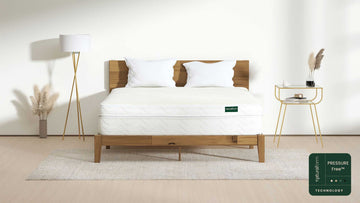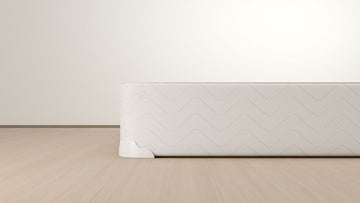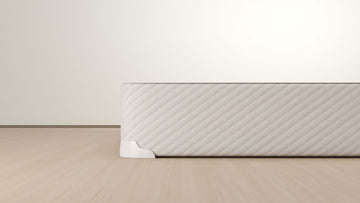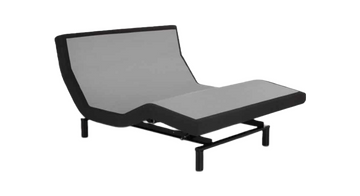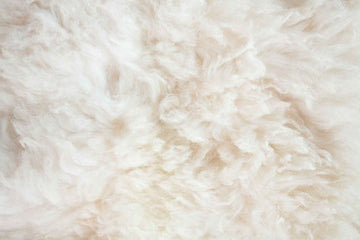There is a common misconception that wool is best suited for warmth in cool conditions. Scientific tests however negate this concept and consistently show that wool is ideal for bedding in hot, humid, dry, cold or wet conditions. Think of it like a thermos for your body — it can keep you warm or cool depending on your needs. Before we go further into why you should choose a wool mattress topper and not a wool mattress entirely, here are some of the benefits wool provides:
- Wool naturally repels dust mites and other little critters
- The soft and luxurious natural Merino wool is completely de-barbed so it doesn’t feel prickly at all.
- Wool breathes more naturally than synthetics & Wool is a natural fiber for comfort and quality.
- Wool naturally wicks away moisture from your body to help you stay at a more consistent and comfortable temperature at night. You’ll stay dry with less perspiring and overheating so you won’t toss and turn so much.
- Wool increases the duration of the most beneficial phase of sleep when you are totally relaxed and dreaming based on studies by the Woolmark® Institute.
- Wool helps you maintain a lower more consistent heart rhythm by as much as 4%.
- Wool facilitates a more comfortable individual body temperature so you fall asleep faster and stay asleep longer regardless of your partner’s temperature or preference.
- Wool keeps you warmer in the winter because wool is one of the best natural insulators
- Wool also helps to keep your skin cooler in the summer by wicking away moisture
- Wool is hygienic and hypoallergenic – it effectively controls the growth of bacteria, mold, mildew and musty odors so it is great for allergy or asthma sufferers
Is a wool mattress topper comfortable?
Wool has unique attributes, which give it superior performance to other fibers in a number of ways. Our bodies continually produce heat at a rate dependent on our activity level; this heat must be dissipated to the surroundings in the form of perspiration, at the same rate at which it is produced, to keep the body temperature constant.
When used in bedding wool creates a micro-climate that assists in regulating body temperature and humidity. The degree to which body temperature and humidity is regulated is known as “thermophysical” comfort, that is, a state in which the individual is free from thermal stress. Wool Mattress Topper & Blanket Sleep Study designed by P.R. Dickson used the subject’s own room and bed as control. Time-lapse photography monitored movement during the night to determine the sleep quality.
Dickson found statistically significant differences in the number of immobile periods, immobile sequences, and the percentage of the total time spent sleeping with the wool mattress topper and/or blanket compared with the acrylic surface. Again the wool mattress topper & blanket was proven to be the most restful surfaces to sleep upon. The positive health effect of sleeping with wool is best illustrated by a study by Scott.
Of low birth weight babies. His study found that babies nursed while wrapped in lamb’s wool consistently showed a significant improvement in weight gain over and above those nursed by conventional methods using cotton.
Moisture wicking abilities
Wool’s comfort advantages have traditionally been attributed to the capacity of the fiber to absorb a significant proportion of its own mass as water.
Wool is a hygroscopic fiber; it takes up moisture in vapor form. Tiny pores in the epicuticle make the fiber semi-permeable, allowing vapor to pass through to the heart of the fiber. Wool can easily absorb up to 30% of its weight in moisture without feeling damp or clammy.
The capacity to absorb makes wool a “temperature regulator” because it can protect the body in both cold and warm conditions. Wool always absorbs moisture from the atmosphere of greater humidity and releases it to the drier environment as it creates a balance in moisture conditions. This characteristic makes wool a versatile all-season fabric.
Other advantages
Another advantage of wool over other fibers is its outstanding insulating properties especially when compared with synthetic fibers.
The unique three-dimensional form of wool allows it to trap small packets of air, thus giving it an insulating property. This property ensures that temperature changes are slow and gradual so that the bed’s micro-climate has time to equilibrate. Rapid changes in heat loss or gain would hinder temperature and humidity regulation.
Wool’s natural resilience is another property which aids in comfort. The pile of an underlay (wool mattress topper) will reduce pressure points and cushion the body. Tests using wool underlays with the elderly and bedridden patients in hospitals have shown dramatic differences between the performance of wool and polyester bed pads.
Patients on wool had significantly fewer skin problems than those of polyester pads. 775 of those on wool had no problems compared to 38% of polyester. Of those with decubitus (skin break down), only 8% had any problems at all for more than one month. Those that slept on polyester had 38% more issues and problems for a period of more than one month.
In addition, no patients on wool had renewal of skin irritation once the initial problem cleared up, while 14% had repetitive periods of irritation on polyester*. The health aspects of sleeping on wool continually outrank similar synthetic products.

